The Stamford Historical Society Presents
Pride and Patriotism: Stamford’s Role in World War II
Online Edition
The Interviews
Roger Preu
Roger Preu enlisted in the Army Air Corps and between 1944 and 1945 and flew 30 bombing missions over Germany. He flew with two separate crews, serving as wing lead bombardier. He won two Distinguished Flying Crosses and five Air Medals. When he retired from the Air Force Reserve, he was a Lt. Colonel.
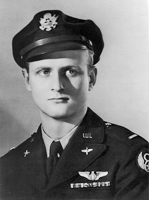 I was in college at Pratt Institute in New York studying to be an art teacher when the war broke out. I enlisted in December of 42 but wasn’t called to active duty until February of 1943. First I went down to Atlantic City, they took over all the hotels for the Air Corps. There were thousands of enlistees of all sorts waiting for different positions to open up at different schools and so forth. We had rifle shooting and marching there…we were supposed to have basic training there. But we weren’t there too long, and after that I was sent to Grove City College in Pennsylvania, 60-70 miles north of Pittsburgh. There were about 70 of us. They had what they called a College Training Detachment. The flying schools were all filled up, so they sent different groups all over the country to these different colleges. You were supposed to stay there about three months and get 10 hours of flying in a Piper Cub. I wanted to fly. I wanted to be a pilot. I was in Grove City only about three weeks and I had about three hours of flying time in a Cub and then I was sent down to Nashville where they had testing to decide what you should become, a bombardier, a navigator or a pilot. I started out in pilots’ school. From there I went down to Montgomery, Alabama, which was big training center for pre-flight on the East Coast. I think they had another one in Santa Clara, California.
I was in college at Pratt Institute in New York studying to be an art teacher when the war broke out. I enlisted in December of 42 but wasn’t called to active duty until February of 1943. First I went down to Atlantic City, they took over all the hotels for the Air Corps. There were thousands of enlistees of all sorts waiting for different positions to open up at different schools and so forth. We had rifle shooting and marching there…we were supposed to have basic training there. But we weren’t there too long, and after that I was sent to Grove City College in Pennsylvania, 60-70 miles north of Pittsburgh. There were about 70 of us. They had what they called a College Training Detachment. The flying schools were all filled up, so they sent different groups all over the country to these different colleges. You were supposed to stay there about three months and get 10 hours of flying in a Piper Cub. I wanted to fly. I wanted to be a pilot. I was in Grove City only about three weeks and I had about three hours of flying time in a Cub and then I was sent down to Nashville where they had testing to decide what you should become, a bombardier, a navigator or a pilot. I started out in pilots’ school. From there I went down to Montgomery, Alabama, which was big training center for pre-flight on the East Coast. I think they had another one in Santa Clara, California.
I was in Nashville for four or five weeks and had all kinds of tests plus marching and running, running all the time. From there I went to Tuscaloosa, Alabama, a little tiny flying school, private flying school actually, and I got about three hours in a PT-17 biplane. I couldn’t land the darn thing smoothly. They told me I had bad depth perception between about 10 and 20 feet and I’d always bounce a little hard. I should have been in the Navy, because they always land tail first, because I always did. One time after about three hours my instructor told me, “If I was pregnant you would have just killed two of me”.
So from there I went to another place…Valdosta, Georgia because I was not going to be a pilot. So they said, do you want to be a bombardier or a navigator? I said a bombardier because being young and stupid and crazy I wanted to kill people. I wanted to do something… I thought being a navigator was being a math man… it had to be too smart to me. So I went down to Valdosta Georgia waiting for an opening at gunnery school. We went to gunnery school down in Florida...there was aerial gunnery and ground gunnery and all that. A bombardier had to shoot guns as well as release bombs. We fired 50 caliber machine guns.
From there I went to bombardier school and on the way from Panama City, Florida we stopped overnight in the troop train in New Orleans and it was New Year’s Eve 1943/44.
We stayed the night...it was wild. We got back on the next day and got to bombardier school in San Angelo, Texas. That was about four months. I did very well there. I was a good bombardier. I think from art school I could see the difference in values very easily, darks and lights more than most people, and I did very well. I was in a plane dropping bombs. We were on an AT-11 there… was twin engine aircraft and it was designed to all different ways…for bombardiers, for navigation, they used it for cross country, they used it for all different things. Our flying instructors, the guys who flew the airplanes, were all men who came back from overseas. A lot of them were fighter pilots and they tried to treat that plane like a fighter...it was great fun. San Angelo is sheep country...flat as it goes, so they tried to get down as low as they could and they really got low...there was nothing between us and North Dakota except for a fence once in a while. That was good. We went to bomb school…and of course the Norden bomb site was supposed to be a big secret…we had to sign away our life, protect it with our life, when we went into class, we couldn’t take notes, you couldn’t bring notes home, we couldn’t bring notes out of the classroom. If we wanted to study more at night, we had to go back to the classroom.
After we did that, we had trainers on the ground that were big ladders… you had a seat in it and you could maneuver it and go along the floor of a big hangar and lock on the target with the bomb site and you could follow it along. After that we flew in the AT 11s two at a time, usually with the pilot. One man would navigate, we picked up dead reckoning navigation. One man had to navigate on the way out, the other guy dropped bombs, then coming back, the guy who dropped bombs was the navigator and you changed positions and you had to take pictures with the camera of where the bombs hit. So just as the bombs went out, you run to the back where there was a little hole in the airplane and you’d shoot with the camera.
We would bomb a big circular target and the circular error from there was very important. If you were 200 feet error from that, you were gone. I don’t know what the cut-off was, but I had a pretty good average. Then we would do some low level bombing from 50-60 feet high, and we would bomb what looked like a ship design. Every so often someone would drop a bomb off the range and hit the sheep country and the ranchers would make sure 200 sheep got killed…. because they could charge the government the full rate even if the sheep was a young one. We always swore they killed more than we did. But every so often someone would drop a bomb off the range and it was a hundred pound bomb… 96 lbs of sand and 4 lbs black powder, so when the bomb hit, there would be a big puff of black smoke. And if you hit the target, the shack it was called, it was built up where you’d see it.
From there I had home leave for the first time for two weeks, coming to Hartford, my hometown. I was assigned to Westover Field in Springfield Massachusetts, a big field, it was a SAC field after the war for years before they closed it. I was there about two weeks, met a crew, we all joined up, different people from the different schools and we were assigned to Charleston, so we took a train down to Charleston. And we were there a couple of months in combat training. There we did everything, we dropped some bombs, light ones mostly, some weighed 250 lbs. There was a B24 school, some got sent to B17 school. And while I was there, once in a while, we had to go on sea search… if there was an airplane or ship that went down, everybody would go out and do a big pattern looking for bodies or whatever they could find. We never found anything.
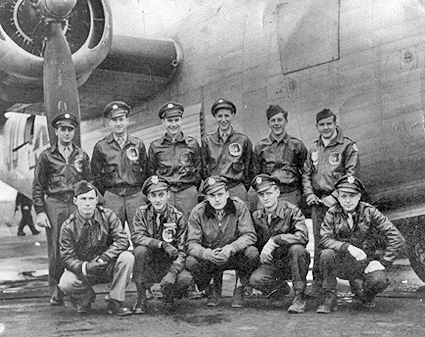 From there I went up to Langley Field...on my way to go overseas basically. We were there three or four weeks while our full time navigator went to radar school… special H-2 sets, special radar for bombing. I did some bombing there, but mostly I did air search for submarines. I didn’t need the training with radar. From there we went over to England. I wanted to get into the 8th Air Force, badly… they were the ones getting all the publicity, the ones you heard about, the Big 8 and all that. That’s where all the action was. It was unfair to the other guys who didn’t get the publicity they should have… Pacific bombers didn’t get it either, not till the B29s came out. When the B29s came out, they were almost all 8th, 10th, 15th Air Force crews who had finished up, gone home and wanted to see action in the Pacific and were assigned to B29s. I stopped at Bangor, Maine. In the middle of the night they woke us up and said, “The weather’s good, you are flying out.” Then we flew to Greenland and were there almost a week, because the weather was bad. In those days you didn’t have the good navigation for traveling that distance. We were on a B24. Then we flew to Iceland, Reykjavik, and we were there almost two days, so it took us two weeks. We were a week in Labrador before Greenland. So it took us two weeks to get to Wales. Then we were assigned to big depot for five or six days, then we were assigned to 446th Bomb Group in East England and the 704th Bomb Squadron. The 446th was famous, because Jimmy Stewart was in the 445th that was very close, and he would come up to our base once and a while. You’d see him from a distance. At that time he was Lt. Colonel. I flew there with my crew for 12 missions. My pilot was older, he had been an instructor for a year and a half – two years from the very beginning of the war. He’d been an instructor in pilot school, so when we got there, a couple of guys who were Lt. Colonels had been his students, but because of the missions they had made Lt. Colonel… and here was this 1st Lieutenant, which did not faze him very much. Excellent pilot of course, he had hundred or thousands of hours of airtime.
From there I went up to Langley Field...on my way to go overseas basically. We were there three or four weeks while our full time navigator went to radar school… special H-2 sets, special radar for bombing. I did some bombing there, but mostly I did air search for submarines. I didn’t need the training with radar. From there we went over to England. I wanted to get into the 8th Air Force, badly… they were the ones getting all the publicity, the ones you heard about, the Big 8 and all that. That’s where all the action was. It was unfair to the other guys who didn’t get the publicity they should have… Pacific bombers didn’t get it either, not till the B29s came out. When the B29s came out, they were almost all 8th, 10th, 15th Air Force crews who had finished up, gone home and wanted to see action in the Pacific and were assigned to B29s. I stopped at Bangor, Maine. In the middle of the night they woke us up and said, “The weather’s good, you are flying out.” Then we flew to Greenland and were there almost a week, because the weather was bad. In those days you didn’t have the good navigation for traveling that distance. We were on a B24. Then we flew to Iceland, Reykjavik, and we were there almost two days, so it took us two weeks. We were a week in Labrador before Greenland. So it took us two weeks to get to Wales. Then we were assigned to big depot for five or six days, then we were assigned to 446th Bomb Group in East England and the 704th Bomb Squadron. The 446th was famous, because Jimmy Stewart was in the 445th that was very close, and he would come up to our base once and a while. You’d see him from a distance. At that time he was Lt. Colonel. I flew there with my crew for 12 missions. My pilot was older, he had been an instructor for a year and a half – two years from the very beginning of the war. He’d been an instructor in pilot school, so when we got there, a couple of guys who were Lt. Colonels had been his students, but because of the missions they had made Lt. Colonel… and here was this 1st Lieutenant, which did not faze him very much. Excellent pilot of course, he had hundred or thousands of hours of airtime.
After 12 missions they took him and put him up in headquarters. He was married, he was older and they said they would build a new crew around me. The lead crew had 10 men basically, but instead of having a co-pilot, you usually had some big shot flying along with you in charge of the whole shebang… Major…Lt. Colonels sometimes. That was in November of 1944, my last mission with my old crew I trained with, we got banged up pretty bad. We had almost no fuel left and we had to come in on a fighter strip right behind the lines. They were very angry, because we took so much fuel… they’d patched up some of the main tanks and put in enough fuel to get us back to England, but we had to land in Laon Couvre just north of Rheims in France. We were lucky, because when we came down our navigation equipment was banged up a little bit… our navigator was a little bit edgy. We didn’t know where the hell we were, because there had been great cloud cover.
We came down and I saw Rheims Cathedral, we had studied that at Pratt, I had even made a sketch of the front of it. I said, “That’s Rheims”…I knew it. We landed just north, that’s all champagne country. There was champagne all over the place. We got back to England that night and I brought back a lot of champagne, which made me very popular. We had been bombing mostly oil refineries in Germany. All but one of my missions was in Germany. I had one mission in France, just after that, but we couldn’t make it. We were supposed to bomb near Metz, for Patton, he was supposed to move in that area and we couldn’t close our flaps on our two right engines, so we had to abort. We didn’t get credit for it…you had to at least get over the coast to get credit for a mission.
We got hit by antiaircraft guns, we never got hit by a fighter. We had fighters near us, but we never had machine gun hits from a fighter. It was rougher in the early days. When I got there, there was a lot of antiaircraft, but we didn’t have the fighters, we didn’t have the losses they had early on in ‘44.
We saw fighters. Near Hamm September ‘44, Jimmy Stewarts’ ex-outfit got hit by maybe 200 German fighters. It was a famous battle. I think they had 30 aircraft, and 25 or 26 of them got shot down over the target, and two or three of them crashed and one plane came home and landed safely. They lost so many people they were going to take us newcomers from the 446th and send us over there. We didn’t want any part of that. They decided not to.
Anyway after 12 missions they decided we were going to be a lead crew. Well that should take about three weeks because they had a good navigator, radar man and me to build the crew around and the new pilot would be fine. And the crew that was training to be the lead crew disappeared… December 3rd in a lot of fog, no one saw them form with the group or with the wing…we figured they went down in the North Sea. They decided the second crew would do, but they flunked out, so I didn’t fly from the middle of November until January 1st 1945. We were waiting. Finally we got the new crew. They patched together a crew and we flew January 1st. That was still the Battle of the Bulge…I think the Bulge was over January 14th. I was going crazy because I wanted to fly and the weather was bad and the crew wasn’t ready…
I spent the time studying with targets. They would send me down to look at pictures, because if you missed the first target because of bad weather, if you had a change of targets, you had to go to secondary, you weren’t really trained enough for that, so I studied…
We usually dropped 2000 pound bombs. We carried four. The back two weren’t quite 2000 pounds because they had smoke bombs in them. On occasion we’d drop 500 pound bombs. Once we dropped 1000 pound bombs. Once my plane and some others… we dropped napalm. They had fighter wing tanks that were leaky...we had napalm in them, that was early January. Supposedly there was a Panzer division in the woods and it was one of the last outfits that could possible be thrown against the Americans, and we dropped all kinds of bombs, heavy personal etc., and we dropped fire bombs to set fire to the woods. The fighters went in afterwards and were shooting up everybody.
On January 16 we were supposed to go to Berlin, on the way they said no, the weather was no good. We were going to go to Ruhrin (?) which was a big oil refinery, and we were after refineries, they did synthetic oil and on the way they changed it to the third target, Lehrte…that was an aluminum factory. We got shot up real badly. Just before we dropped bombs, we got hit by four 88 shells. One exploded below me. A small piece shot up and hit me in the fanny, it didn’t cut me, didn’t rip my pants…just hit me. One went through the left wing tank and the gas poured out and flew into the bomb bays, and it was all steamy. Engineer was a sharp kid he said, “That’s not smoke, that’s gas” and he went out and put his hand on the hole and held off enough till they transferred a little fuel.
When we tried to hit the target we got hit and bounced up and came down again, and the bombsight was useless. We just dropped our bombs...we were in the general area…we didn’t actually hit the factory. But we hit the railroad yards next to it where a lot of trains were either loaded or unloading, so we figured we did something. But coming back we had to lead the group, we couldn’t fly, we had an engine out and the other sputtering, we couldn’t keep up with the group. And that was the worst moment of my life, when we pulled out of formation, because the next plane to fly over us was the one with my original crew with the co-pilot who was my best friend. He waved at me and I waved at him…I thought we’d never get home. We came all the way back from the middle of Germany and there were 8 or 10 other planes in the area that were all banged up, and that’s when we saw fighters. But they never hit us. They went after some of the others…we couldn’t figure it, because we had so much damage we were afraid to even fire a gun, because it might spark something. Coming back there was cloud cover and we couldn’t maneuver to well and we went over Stuttgart and they started to hit us. Now the four shells that hit us left us with holes, but going over Stuttgart we got slaughtered with little holes, we got hit again and again from a distance, just tiny bits of shrapnel. When we finally got down we landed in France just over the lines again, we came down on another emergency fighter strip and we had no hydraulics, communication all banged up… fuel gone, engines real bad shape. Pilot did a great job of getting it in there and we stayed that night at the fighter strip, and the crew went out and counted over two hundred holes, but no damage from them…just damage from the first four. We were lucky.
We were given two weeks leave after that. We were stuck in France for a few days because the troops were moving forward. But then we traveled to Paris, we were there for two or three days and then flew to England. When we got back at the base the Colonel was shocked...he didn’t realize we were still alive. We were returning from MIA status. I was a First Lieutenant at the time. I went down to Southampton etc. during my leave.
February 22nd we bombed at low altitude 10,000 feet. 3rd Army was moving forward and Patton wanted the railroads closed down. So we went in, one group at a time, bombed the railroad roundhouse the pictures are of. We got a commendation for that close bombing. It was south of Berlin...Nordheim. We started to finish up in March, bombed Hamburg, Magdeburg, sub pens…etc. My crew finished one mission ahead of me. They planned it to fly a certain number of missions depending on loss ratios. General 25 missions in Europe, 50 in Pacific, then raised it to 30 for lead crews and 35 for others. Last day I flew as an observer.
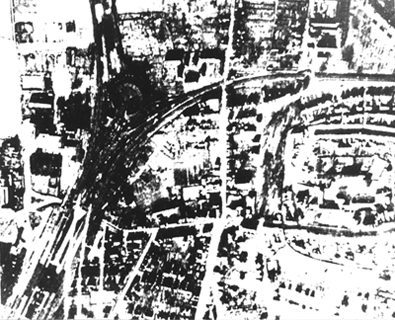
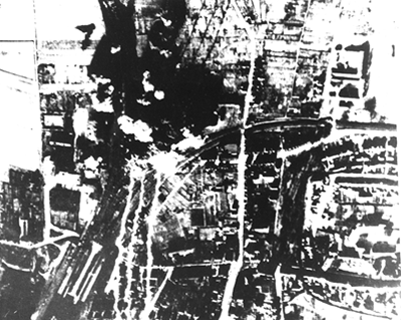
Railroad roundhouse bombing site, before and after.
On D-day my group was the first group over the coast.
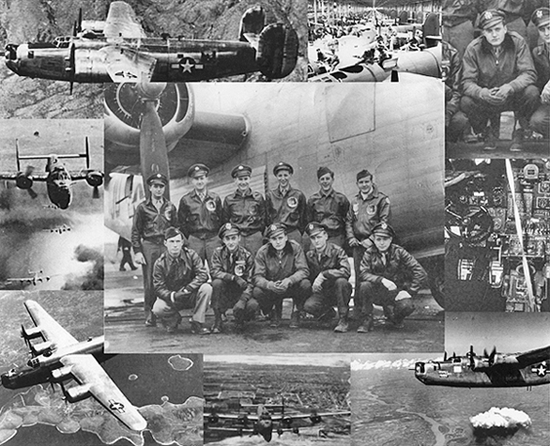
an original collage (from a photocopy)
I got out in August of 1945. It was too late to go over to the Pacific. I had a lot of points. I went back to college. Got a job teaching in Stamford and that was it. I flew 17 missions with the second crew, 12 with the first and one as an observer.
Photos Courtesy Roger Preu
United States Army Air Forces / Eighth Air Force
Overview of Air Force Combat Units of World War II
The Movement Toward Air Autonomy
back to top
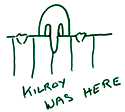 Introduction
Introduction
Veterans
Battles
Stamford Service Rolls
Homefront
Exhibit Photos
Opening Day

